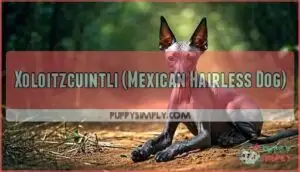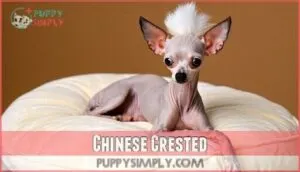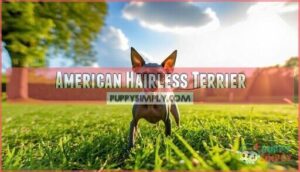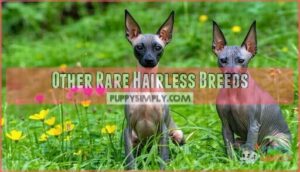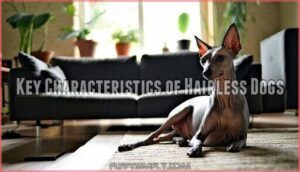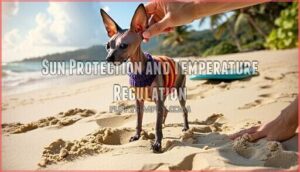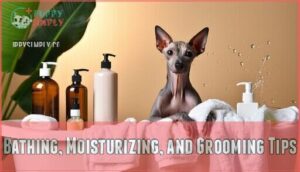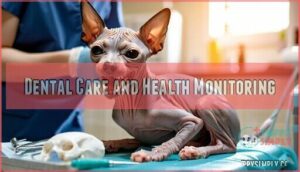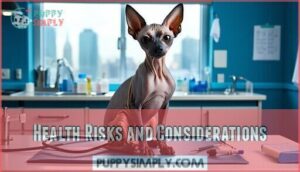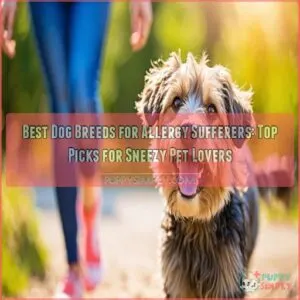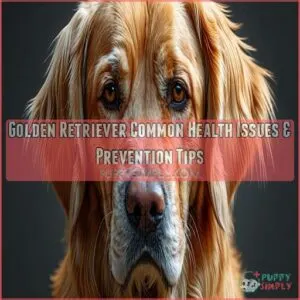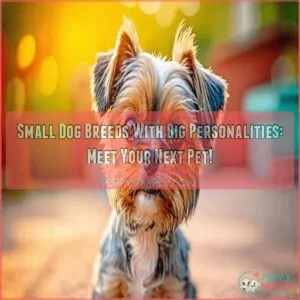This site is supported by our readers. We may earn a commission, at no cost to you, if you purchase through links.
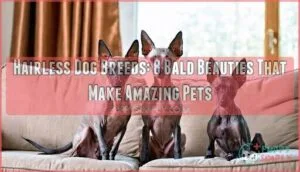
These breeds carry the FOXI3 gene mutation that prevents normal hair follicle development, resulting in smooth, warm skin that feels like a living heating pad. Their calm, affectionate temperaments make them perfect lap dogs, though they’re surprisingly intelligent and trainable.
Don’t let their bald appearance fool you—they’re not maintenance-free pets. Their exposed skin requires daily sunscreen, gentle moisturizing, and regular dental care since many hairless breeds struggle with missing teeth.
Table Of Contents
Key Takeaways
- You’ll need specialized care routines – hairless breeds require daily sunscreen, gentle moisturizers, and regular dental checkups since the same genes causing hairlessness often create missing teeth and skin sensitivity.
- They’re not truly maintenance-free despite lacking fur – these dogs need more skincare attention than coated breeds, including twice-weekly baths with pH-balanced shampoos and protection from temperature extremes.
- You can’t assume they’re completely hypoallergenic – while they don’t shed fur, their skin still produces dander and oils that can trigger allergies, requiring consistent bathing to minimize allergens.
- You’ll pay premium prices for these rare breeds – expect $2,500-$4,000 for breeds like Xoloitzcuintlis, plus ongoing costs for specialized skincare products, sun protection, and veterinary care.
What Makes a Dog Breed Hairless?
You might wonder why some dogs lack the fluffy coats we’re used to seeing. Hairless dog breeds carry a rare genetic mutation that prevents normal hair follicle development, resulting in smooth, bare skin instead of a typical fur coat.
Genetic Traits Behind Hairlessness
Several genetic mutations control whether your furry friend rocks a bald look. The FOXI3 gene is the main player, creating inheritance patterns where you’ll see hairless traits passed from generation to generation.
These genetic factors affect different hairless dog breeds like the Xoloitzcuintli, making genetic testing valuable for understanding breed variations and predicting hairlessness in offspring.
Types of Hairless Dog Breeds
You’ll find hairless dog breeds fall into two main categories. Complete hairless breeds like the Xoloitzcuintli, Chinese Crested, and Peruvian Inca Orchid have minimal to no hair. Partial hairless breeds retain some hair patches.
Hairless Breed Classification includes four AKC-recognized breeds, while Rare Breed Profiles feature unregistered varieties like Argentine Pila.
Common Physical Features
Recognizing hairless dog breeds means understanding their unique skin types and body structure. You’ll notice these dogs display smooth, warm skin that feels like leather. Their facial features often appear more prominent without fur, while coat variations range from completely bald to sparse hair patches.
Most hairless dogs maintain excellent muscle tone, requiring specialized dog skin care for ideal canine health.
Popular Hairless Dog Breeds
You’ll discover that three primary hairless breeds dominate the canine world: the ancient Xoloitzcuintli from Mexico, the playful Chinese Crested, and the energetic American Hairless Terrier.
Each breed offers unique characteristics, from the Xolo’s calm temperament to the Chinese Crested’s lively personality, making them excellent companions for families seeking low-shedding pets.
Xoloitzcuintli (Mexican Hairless Dog)
Meet the Xoloitzcuintli, Mexico’s ancient treasure with Mexican origins spanning over 3,000 years. This hairless dog breed carries unique hairless genetics that make them perfect hypoallergenic dogs. Their ancient history includes sacred roles in Aztec culture.
The Xoloitzcuintli stands as Mexico’s 3,000-year-old sacred treasure, embodying ancient Aztec culture in its unique hairless genetics
Key features of this Mexican hairless:
- Available in three sizes (toy, miniature, standard)
- Rare colors include slate gray, bronze, and black
- Calm, loyal temperament ideal for families
- Breed standards require smooth, warm skin
Chinese Crested
The Chinese Crested comes in two varieties within the same litter: hairless and powderpuff. These hypoallergenic dogs need specialized Chinese Crested grooming routines.
Hairless Care Tips include regular bathing and moisturizing their exposed skin. Powderpuffs require daily brushing to prevent matting.
Both varieties make loyal, low-shedding dogs perfect for allergy sufferers seeking companionship.
American Hairless Terrier
The American Hairless Terrier brings true American temperament to hairless dog breeds. Born from Louisiana’s rat terrier lineage, this breed’s hairless genetics emerged through selective breeding in the 1970s.
You’ll find terrier training straightforward with their intelligent, eager-to-please nature. Their breed history shows notable genetic diversity retention. Terrier socialization helps channel their natural hunting instincts positively.
These low shedding dogs need minimal dog grooming needs compared to coated breeds.
Other Rare Hairless Breeds
Beyond the well-known American Hairless Terrier, rare breed profiles reveal fascinating exotic canines steeped in hairless breed history. Genetic research shows these ancient breeds face conservation challenges, making them precious finds for dedicated owners.
The Peruvian Inca Orchid is often sought after for its loyal and affectionate nature, making it an ideal candidate for dog therapy work.
- Peruvian Inca Orchid: Peru’s 2,000-year-old treasure with incomplete dentition linked to hairlessness genetics
- Argentine Pila Dog: Only 1,700 exist in Argentina’s Salta province, prized for family-friendly temperaments
- Bolivian Hairless Dog: Features two distinct size types and requires experienced handling due to strong-willed nature
Key Characteristics of Hairless Dogs
You’ll notice that hairless dog breeds share several distinct traits that set them apart from their furry counterparts. These breeds usually have smooth, warm skin that requires special care, come in various sizes from toy to medium, and often display calm, affectionate temperaments that make them excellent companions for families seeking hypoallergenic pets.
Physical Appearance and Size Variations
You’ll find hairless dog breeds come in notable size variations, from toy-sized Chinese Crested dogs to medium-sized Xoloitzcuintli. These breeds showcase diverse body types and muscle structure patterns.
Skin colors range from black to pink, while some breeds like the Peruvian Inca Orchid display spotted coat patterns on their remaining hair patches.
Temperament and Behavior
Hairless dog breeds showcase fascinating personalities that’ll warm your heart. Most hairless dogs display calm, affectionate temperaments with strong human bonds.
They’re intelligent companions requiring consistent socialization needs and respond well to positive training tips. Understanding canine body language helps you connect with their emotional intelligence.
These breeds often show excellent breed compatibility with families seeking loyal, cuddly pets.
Hypoallergenic and Allergy-Friendly Qualities
Freedom from constant sneezing fits becomes reality with hairless dog breeds. These low shedding companions offer significant allergen reduction for sensitive skin sufferers. Here’s why they’re your allergy prevention allies:
- Minimal pet dander production – no fur means less airborne irritants
- Easy allergen removal through regular bathing
- Reduced grooming allergens compared to coated breeds
- Cleaner home environment with less hair accumulation
- Direct skin contact helps identify and manage reactions quickly
Essential Care for Hairless Dog Breeds
You’ll need to establish a consistent skincare routine that includes regular bathing with gentle, pH-balanced shampoos and applying dog-safe moisturizers to prevent dryness and irritation.
Sun protection becomes critical since these breeds can develop painful sunburns and skin damage within minutes of UV exposure, requiring SPF 30+ pet-safe sunscreen and protective clothing during outdoor activities.
Sun Protection and Temperature Regulation
Your hairless dog’s exposed skin needs daily protection from UV rays and temperature extremes. Apply pet-safe sunscreen with SPF 30+ before outdoor activities to prevent skin cancer.
During hot weather, limit exercise to cooler hours and watch for heatstroke signs. Cold weather protection includes sweaters or jackets since hairlessness makes temperature control challenging for these breeds.
Bathing, Moisturizing, and Grooming Tips
Beyond sun protection, you’ll need proper bathing techniques for hairless dog care. Bath your pet twice weekly using gentle shampoos that remove dead skin cells.
Apply dog-safe moisturizer afterward to prevent dryness. Skip harsh grooming tools—soft cloths work best.
Choose moisturizers specifically formulated for hairless breeds to maintain healthy skin conditions and support ideal pet grooming routines.
Dental Care and Health Monitoring
Your hairless dog’s oral health requires special attention because hairlessness creates unique dental challenges. The same genetic mutation causing hairlessness affects tooth development, often resulting in missing teeth.
- Daily brushing protects against bacterial buildup that leads to painful infections
- Missing teeth make remaining ones work harder, increasing decay risk
- Early gum disease detection prevents heart and kidney complications
- Professional canine dentistry visits catch problems before they worsen
- Healthy teeth mean better nutrition and a happier, more comfortable dog
Understanding the genetic tooth issues is necessary for maintaining your dog’s oral health.
Health Risks and Considerations
You’ll need to stay alert for specific health challenges that come with owning a hairless dog breed, from skin conditions to genetic issues.
These beautiful companions require proactive veterinary care and preventive measures to keep them healthy and comfortable throughout their lives.
Common Skin Conditions and Allergies
Owning hairless dog breeds means coping with unique skin challenges that furry companions rarely face. Skin allergies and hairless dermatitis are common concerns, with direct environmental exposure triggering reactions.
Canine acne often develops during adolescence, creating red bumps on exposed areas. Sunburn prevention becomes critical since UV rays directly hit bare skin.
Skin infections develop faster without fur’s protective barrier. These hypoallergenic breeds ironically face more skin conditions than traditional dogs, requiring vigilant monitoring and prompt veterinary care for ideal health.
Dental Health and Genetic Issues
Your hairless dog breeds face a double whammy with dental problems. The same genes causing hairlessness often trigger missing teeth and jaw issues. Tooth decay happens faster without proper orthodontic care.
You’ll need genetic testing to understand your pup’s risks. Regular dental checkups prevent serious complications in these skin conditions-prone breeds.
Veterinary Care and Preventive Measures
Why wait until problems surface? Regular veterinary checkups catch skin cancer and other issues early in hairless dog breeds.
Schedule health screening every six months, discuss preventive medication options, and consider genetic testing for hereditary conditions.
Your hypoallergenic companion deserves proactive dog care—think of checkups as insurance for your dog’s health and your peace of mind.
Frequently Asked Questions (FAQs)
Are hairless dogs hypoallergenic and suitable for people with allergies?
Surprisingly, you’ll discover these breeds aren’t automatically hypoallergenic. While they don’t shed fur, their skin produces dander and oils that can trigger allergies.
You’ll still need regular baths and skincare to minimize allergens.
Are hairless dogs more expensive than regular breeds?
You’ll usually pay more—Xoloitzcuintlis run $2,500-$4,000, and specialty care costs add up. Their rarity means higher breeder prices, plus ongoing expenses for special skincare and sun protection.
Can hairless dogs swim safely in pools?
Yes, you can swim with them safely in well-balanced pools. Chlorinated or saltwater pools are usually safe with supervision.
Rinse thoroughly with fresh water afterward and limit daily swimming time to protect their sensitive skin.
What clothing works best for hairless breeds?
Clothing is your secret weapon against Mother Nature’s moodiness. For sun protection, opt for lightweight, breathable fabrics. When it’s cold, bodysuits covering your dog’s entire body are essential.
Choose UPF-rated materials for UV defense and windproof, waterproof options for harsh conditions.
How do hairless dogs handle air conditioning?
Air conditioning can be tough on your pup’s bare skin since they’re naturally more sensitive to temperature changes. Monitor them for shivering or excessive coldness.
Adjust thermostat settings between 72-78°F and consider cozy sweaters.
Conclusion
Statistics show that 10% of dog allergies stem from dander, not fur, making hairless dog breeds potentially problematic for some sensitive individuals. However, these unique companions offer warmth, loyalty, and fascinating genetics that’ll capture your heart.
You’ll need commitment for proper skincare, sun protection, and dental maintenance, but the reward is a devoted friend with ancient heritage. Whether you choose a Xoloitzcuintli, Chinese Crested, or American Hairless Terrier, these hairless dog breeds provide unconditional love wrapped in smooth, touchable skin.
- https://www.dogster.com/lifestyle/hairless-dog-breeds
- https://www.akc.org/dog-breeds/xoloitzcuintli/
- https://www.houndsy.com/blogs/modern-tails/understanding-xoloitzcuintli-health-problems-a-comprehensive-guide-for-pet-owners
- https://www.omlet.us/breeds/dogs/mexican_hairless/
- https://vgl.ucdavis.edu/sites/g/files/dgvnsk15116/files/media/documents/AHT_Report_20221207.pdf

